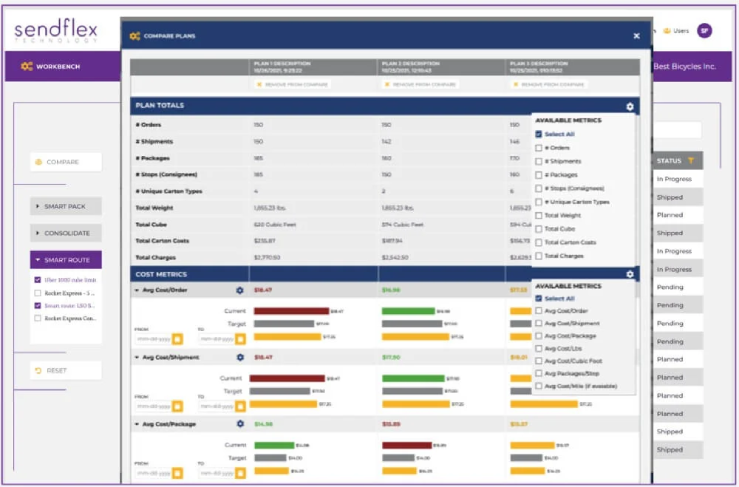Article: Need for Speed: When Carrier APIs Just Won’t Cut It.
The emergence of carrier APIs was a blessing for those of us in the parcel shipping software business. They made shipping execution so much easier, especially with only one or two carriers to consider. Carrier rating API performance was never a critical issue because shipment processing speeds were paced by label printing, not rate API requests.
And no, rate shopping was never really a thing other than as hype. Shippers generally know which carrier service they were going to use.
But with the acceleration of B2C eCommerce parcel volumes and customers demanding more delivery options, shippers are diversifying their mix of carrier services and implementing omni-channel shipping strategies to compete with Amazon.

More carrier rating in more places
As a result, significant complexity has crept into the carrier service selection process over the last few years. Shippers now need to consider many variables including rates, delivery promises, carrier pickup limits and incentives, and other business rules that are now applied across many more carriers.
So, the need for faster and more frequent carrier rating has never been greater. And in more areas outside of shipping including:
- Freight quoting: whether in shopping carts or order entry, the ability to quickly determine accurate rates across a wider network of carriers is crucial. Guesswork and rules of thumb are inadequate, especially now with shipping costs sharply increasing. Guess high and risk losing a customer. Guess low and lose margin. Read more about efficient and accurate rate quoting in our last blog.
- Fulfillment: in the new omni-channel fulfillment world, where you ship from and how you pack an order will have a significant impact. Shippers need to plan fulfillment, considering a wider range of rates, DIM factors, and transit times. And they need to do it quickly in high-volume shipping environments if they expect to make and keep their customer delivery promises.
- Forecasting: change is now a constant in B2C fulfillment. Shippers need a way to simulate “what-if” scenarios based on historical or forecast data, and then measure the transportation cost impact. This requires many more, and faster, carrier rate calculations to minimize the time it takes to analyze results.
Carrier rating APIs were never architected to support the sheer volume of requests required by these use cases. In fact, most carriers set limits in their contracts about how their APIs are used. They will throttle down response times or “deny service” if they see any system hammering away at their APIs. And you can’t blame them.
New parcel TMS platforms feature onboard, hyper-fast rating engines
The quality, reliability, and availability of rating APIs vary widely across carriers. Anyone who has ever attempted to connect to multiple rating APIs to automate the carrier service selection process knows that performance is only as good as the slowest carrier API. That’s not good enough for shippers trying to control costs and delivery performance.
New parcel TMS platforms provide a no-code, carrier API-independent means for applying complex carrier selection rules and making hyper-fast rate calculations in milliseconds. They use analytic work benches to create and compare freight quotes, fulfillment plans, and “what if” simulations to optimize cost control, cube utilization, and customer delivery experiences.
Without having to engage data scientists, logistics managers could run and compare the following types of planning and simulation models using onboard rating:
- “What if I consolidate and drop ship today’s orders into Las Vegas for final mile delivery? What would the impact be on cost and delivery times?”
- “What if I had used a regional carrier to service a specific zip code range last November. What would the impact have been on my shipping costs and primary carrier contract incentives?”
- “Which fulfillment centers should I use for tomorrow’s orders based on carrier rates, transit time, inventory availability, and labor?”
- “What if I had used a different carton type to my order fulfillment process last month? How would that have affected my cube utilization and DIM fees.
- “What if I lower the daily pickup limit for carrier x today and shift routing to another carrier?

There is a time and a place for carrier API calculations, especially during shipment processing. But when it comes to analyzing transportation cost-effective fulfillment, parcel TMS rating engines satisfy the need for speed.
Download our latest ebook, “The Five Parcel TMS Value Pillars”, to learn more about how next generation parcel TMS platforms are facilitating fast, efficient, and accurate freight quoting, planning, and forecasting to better control costs, capacity, carbon, and customer delivery experiences without compromising productivity and speed.
Request a parcel TMS consultation to learn more about how Sendflex can help you meet the need for rating speed.
LEARN
Download
The Five Parcel TMS
Value Pillars
EBOOK
Learn why controlling costs, capacity, carbon, and customer experiences matters in the B2C delivery economy
Shippers who are used to relying on a primary parcel carrier with unlimited capacity must now manage a broader portfolio of carriers, all with different capabilities, performance records, constraints, and rate structures.
DELIVERY CONSULTATION
See What Sendflex Can Do for You
Are you struggling to keep up with the consumer demand for faster, cheaper delivery service options? Is it time for a smart multi-carrier parcel solution?
Whether deployed on premise or accessed from the cloud, our shipping platform apps and APIs support your entire extended enterprise: carrier selection, rating and routing, cartonization, shipping and drop shipping, tracking, and returns.
